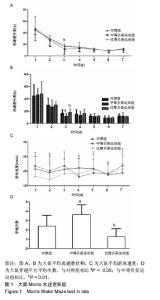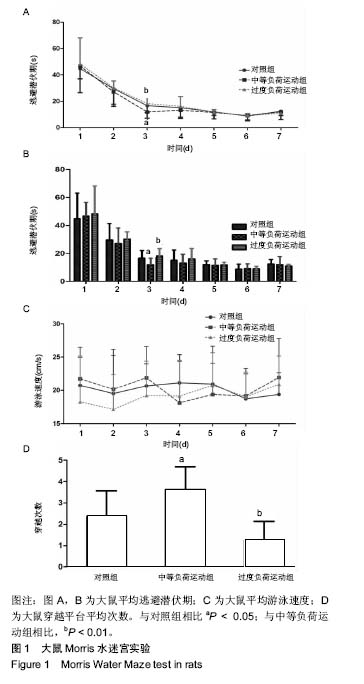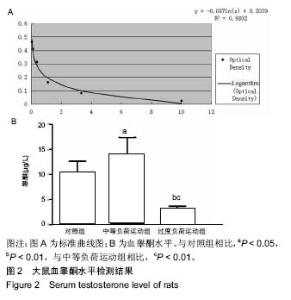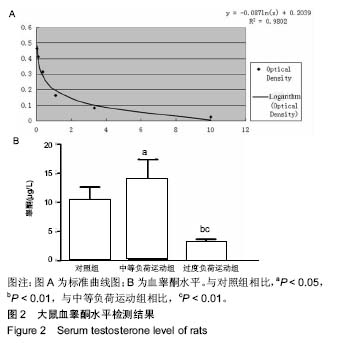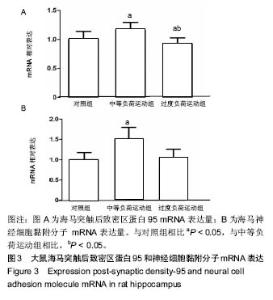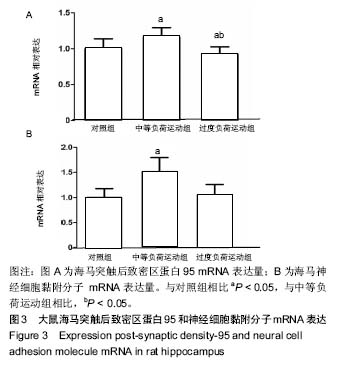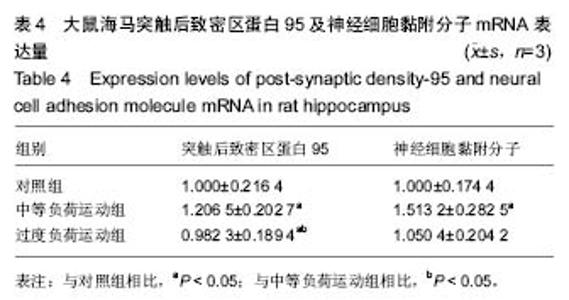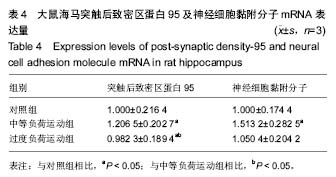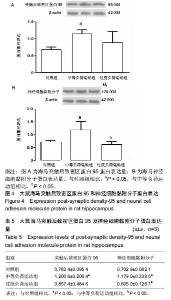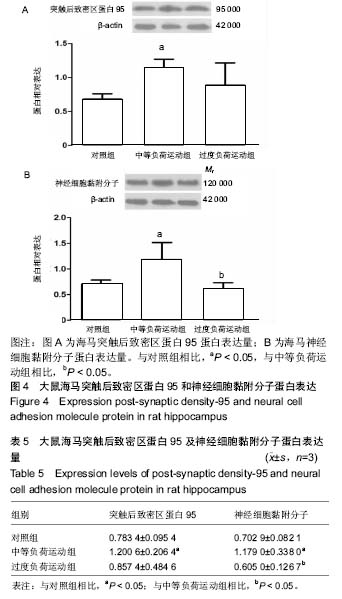| [1] Dishman RK. Brain monoamines, exercise, and behavioral stress: animal models. Med Sci Sports Exerc. 1997;29(1): 63-74. [2] Carek PJ, Laibstain SE, Carek SM. Exercise for the treatment of depression and anxiety. Int J Psychiatry Med.2011;41(1): 15-28.[3] 王佩,王海祥,王维平.突触可塑性与学习记忆[J].脑与神经疾病杂志, 2008,16(5): 651-653.[4] 韩太真.突触可塑性与长时程增强现象的研究进展[J].西安交通大学学报(医学版), 2005,26(4): 305-308,315.[5] 陈燕.神经元的突触可塑性与学习和记忆[J].生物化学与生物物理进展, 2008,35(6): 610-619.[6] Zeidman P, Maguire EA. Anterior hippocampus: the anatomy of perception, imagination and episodic memory. Nat Rev Neurosci. 2016;17(3):173-182.[7] Lazarov O, Hollands C. Hippocampal neurogenesis: Learning to remember. Prog Neurobiol. 2016;138-140:1-18.[8] Chen X, Levy JM, Hou A,et al. 95 family MAGUKs are essential for anchoring AMPA and NMDA receptor complexes at the postsynaptic density. Proc Natl Acad Sci U S A. 2015; 112(50):E6983-6992.[9] 袁琼嘉,张金梅,邓文骞,等.衰老过程中的运动干预对大鼠学习记忆能力及海马神经粘附分子表达的影响[J].体育科学, 2014,34(8): 85-90.[10] 袁琼嘉,李垂坤,李雪,等.长期中等负荷运动对大鼠空间学习记忆及海马神经黏附分子的影响[J].中国运动医学杂志,2012,31(12): 1075-1080,1106.[11] 王桂华,栾海云,马春蕾,等.不同负荷规律运动对老年大鼠空间学习记忆能力的影响及其机制[J].中国老年学杂志, 2014,34 (10): 2822-2824.[12] Duzel E, van Praag H, Sendtner M. Can physical exercise in old age improve memory and hippocampal function?. Brain, 2016;139(Pt 3): 662-673.[13] Wang H, Peng RY. Basic roles of key molecules connected with NMDAR signaling pathway on regulating learning and memory and synaptic plasticity. Mil Med Res. 2016;3(1):26.[14] Razmi A, Sahebgharani M, Khani MH,et al. Cyclic AMP pathway modifies memory through neural cell adhesion molecule alterations in the rat hippocampus. Acta Med Iran. 2014;52(4):246-255. [15] Senkov O, Sun M, Weinhold B,et al. Polysialylated neural cell adhesion molecule is involved in induction of long-term potentiation and memory acquisition and consolidation in a fear-conditioning paradigm. J Neurosci. 2006;26(42): 10888-109898.[16] Bisaz R, Sandi C. The role of NCAM in auditory fear conditioning and its modulation by stress: a focus on the amygdala. Genes Brain Behav. 2010;9(4):353-364. [17] Wang R, Holsinger RMD. Exercise-induced brain-derived neurotrophic factor expression: Therapeutic implications for Alzheimer’s dementia. Ageing Res Rev. 2018;48:109-121. [18] 付燕,张业廷,袁琼嘉,等.有氧运动对D-半乳糖诱导的脑衰老大鼠前额叶SYP、95表达的影响[J].中国运动医学杂志, 2017,36 (7): 563-570.[19] D'Hooge R, De Deyn PP. Applications of the Morris water maze in the study of learning and memory. Brain Res Brain Res Rev. 2001;36(1):60-90.[20] Livak KJ, Schmittgen TD. Analysis of relative gene expression data using real-time quantitative PCR and the 2(-Delta Delta C(T)) Method. Methods. 2001;25(4):402-408.[21] 韦秀霞. 不同运动时长及运动负荷对大鼠睾酮及炎症因子影响的研究[D]. 扬州:扬州大学,2018.[22] 李芳辉.不同水平运动量对睾酮水平的影响[J].三峡大学学报(人文社会科学版),2017,39(S2):238-239.[23] 汤昆,张漓.5周间歇性亚极限强度运动中大鼠睾丸组织StAR及其调控因子的时序性变化[J].中国体育科技,2017,53(6):95-100.[24] Erickson KI, Voss MW, Prakash RS,et al. Exercise training increases size of hippocampus and improves memory. Proc Natl Acad Sci U S A. 2011;108(7):3017-3022.[25] Arida RM, Scorza CA, da Silva AV,et al. Differential effects of spontaneous versus forced exercise in rats on the staining of parvalbumin-positive neurons in the hippocampal formation. Neurosci Lett.2004;364(3): 135-138.[26] Eadie BD, Redila VA, Christie BR. Voluntary exercise alters the cytoarchitecture of the adult dentate gyrus by increasing cellular proliferation, dendritic complexity, and spine density. J Comp Neurol.2005;486(1): 39-47.[27] Van der Borght K, Kobor-Nyakas DE, Klauke K,et al. Physical Exercise Leads to Rapid Adaptations in Hippocampal Vasculature: Temporal Dynamics and Relationship to Cell Proliferation and Neurogenesis. Hippocampus.2009;19(10): 928-936.[28] Liu PZ, Nusslock R.Exercise and hippocampal neurogenesis: a dogma re-examined and lessons learned.Neural Regen Res. 2018;13(8):1354-1355.[29] Hyodo K, Dan I, Suwabe K,et al. Acute moderate exercise enhances compensatory brain activation in older adults. Neurobiol Aging. 2012;33(11):2621-2632.[30] Clark PJ, Brzezinska WJ, Thomas MW,et al. Intact neurogenesis is required for benefits of exercise on spatial memory but not motor performance or contextual fear conditioning in C57BL/6J mice. Neuroscience.2008;155(4): 1048-1058.[31] Zeng M, Shang Y, Araki Y,et al. Phase Transition in Postsynaptic Densities Underlies Formation of Synaptic Complexes and Synaptic Plasticity. Cell.2016;166(5): 1163-75.e12.[32] Sen A, Hongpaisan J, Wang D,et al. Protein Kinase C (PKC) Promotes Synaptogenesis through Membrane Accumulation of the Postsynaptic Density Protein 95. J Biol Chem. 2016; 291(32):16462-16476.[33] Dallerac G, Rampon C, Doyere V. NCAM function in the adult brain: lessons from mimetic peptides and therapeutic potential. Neurochem Res.2013; 38(6): 1163-1173.[34] Brandewiede J, Jakovcevski M, Stork O,et al. Role of stress system disturbance and enhanced novelty response in spatial learning of NCAM-deficient mice. Stress. 2013;16(6):638-646. |
